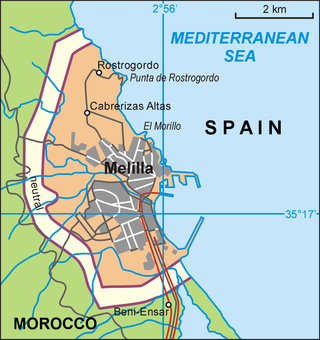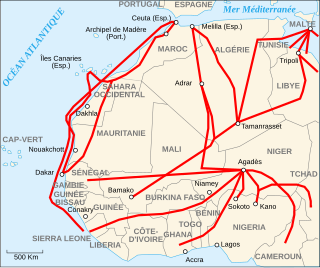
Ceuta is an autonomous city of Spain on the North African coast.

Melilla is an autonomous city of Spain in North Africa. It lies on the eastern side of the Cape Three Forks, bordering Morocco and facing the Mediterranean Sea. It has an area of 12.3 km2 (4.7 sq mi). It was part of the Province of Málaga until 14 March 1995, when the Statute of Autonomy of Melilla was passed.

Perejil Island, also known as Parsley Island, is a small, uninhabited rocky islet located 200 metres (660 ft) off the coast of Morocco. It is administered by Spain as one of the plazas de soberanía, and its sovereignty is disputed by Morocco. It was the subject of an armed incident between the two countries in 2002.

The plazas de soberanía are a series of Spanish overseas minor territories scattered along the Mediterranean coast bordering Morocco in Africa, or that are closer to Africa than Europe. This term is used for those territories that have been a part of Spain since the formation of the modern country (1492–1556), as opposed to African territories acquired by Spain during the 19th and early 20th centuries in the Scramble for Africa.

The Ceuta border fence forms part of the Morocco–Spain border at Ceuta, a city on the North African coast. Constructed by Spain, its purpose is to prevent smuggling and to stop migrants from entering Europe. Morocco objected to the construction of the barrier since it does not recognize Spanish sovereignty in Ceuta.

The Melilla border fence forms part of the Morocco–Spain border in the city of Melilla, one of two Spanish cities in north Africa. Constructed by Spain, its stated purpose is to stop illegal immigration and smuggling. Melilla's border and its equivalent in Ceuta, also bordering Morocco, are the only two land borders between the European Union and an African country.

The Mexico–United States border is an international border separating Mexico and the United States, extending from the Pacific Ocean in the west to the Gulf of Mexico in the east. The border traverses a variety of terrains, ranging from urban areas to deserts. The Mexico–U.S. border is the most frequently crossed border in the world with approximately 350 million documented crossings annually. It is the tenth-longest border between two countries in the world.

Morocco is a neighbouring and associated country of the European Union. The nation has a territorial land border with EU member Spain in the exclaves of Ceuta and Melilla. It also has a maritime border with Spain through the Gibraltar Strait and Exclusive Economic Zone borders with EU member Portugal in the Atlantic. The relations between the two are framed in the European Neighbourhood Policy (ENP) and the Union for the Mediterranean. Among the ENP countries, Morocco has been recognised an advanced status, opening up to high levels of political cooperation.

Melilla Airport is an airport located in Melilla, an exclave of Spain in Africa. The airport is located about 4 km (2.5 mi) southwest of the city, near the border with Morocco. Between 1931 and 1967 Melilla was served by the Tauima Aerodrome, even when Morocco had gained its independence in 1956. This Spanish controlled airport did not open until 1969. It has the capacity to move up to 500,000 passengers and the annual average number of passengers is around 400,000.

Migrants' routes encompass the primary geographical routes from tropical Africa to Europe, which individuals undertake in search of residence and employment opportunities not available in their home countries. While Europe remains the predominant destination for most migrants, alternate routes also direct migrants towards South Africa and Asia.

MoroccoandSpain maintain extensive diplomatic, commercial, and military ties. The Morocco–Spain border separates the plazas de soberanía on the Mediterranean coast from the Moroccan mainland. Morocco's foreign policy has focused on Western partners, including neighboring Spain. Relations have, however, been historically tense and conflictive.

Porteadoras are bale workers in the Spanish autonomous cities of Melilla and Ceuta, located on the north coast of Africa.

The Morocco–Spain land border consists of three non-contiguous lines totalling 18.5 km around the Spanish territories of Ceuta, Peñón de Vélez de la Gomera and Melilla. Spanish islets such as the Chafarinas or the Alhucemas are located off the Moroccan coast.

Fernando Grande-Marlaska Gómez is a Spanish judge and politician who has served as minister of the Interior since June 2018. An independent politician close to the Spanish Socialist Workers' Party, he has been Member of the Congress of Deputies from 2019 to 2020, and briefly from August to December 2023, representing Cádiz.

Helena Maleno Garzón is a Spanish-Moroccan human rights defender, journalist, researcher, documentalist and writer. She is specialist in the migration and trafficking in human beings, Doctor Honoris Causa from the University of Illes Balears. She is the Founder & CEO of Caminando Fronteras / Walking Borders.

The nations of Belarus and Mexico established diplomatic relations in 1992. Both nations are members of the United Nations.
The migration and asylum policy of the European Union is within the area of freedom, security and justice, established to develop and harmonise principles and measures used by member countries of the European Union to regulate migration processes and to manage issues concerning asylum and refugee status in the European Union.

The 2012 Peñón de Vélez de la Gomera incident was a territorial incident that involved Spain and Morocco, the second fought in the 21st century after the one that occurred on Perejil Island in 2002.

The 2021 Morocco–Spain border incident was a migratory incident caused by the massive crossing of people along the beaches of the border between both countries in the direction of Ceuta and Melilla in Spain that began on 17 May 2021. It originated due to a deterioration in diplomatic relations between the Moroccan monarchy and the Government of Spain, after the latter admitted the transfer of the main representative of the Saharawi independence movement Polisario Front to a Spanish hospital in La Rioja, in April 2021. A month after the hospitalization, the Moroccan security forces located on the border in Ceuta relaxed the last control mechanisms, allowing the passage of migrants from Morocco to the Spanish city, most of whom made the journey by swimming.

On 27 March 2023, a fire occurred at an immigration detention center in Ciudad Juárez, Chihuahua, Mexico, near the border with the United States. The fire killed 40 people and left 27 others seriously injured. According to Vice interviewees, prison officials demanded bribes from migrants to release them and avoid deportation. The fire was allegedly started by inmates when they set fire to their mattresses to protest their detention conditions and impending deportation. CCTV security footage obtained by the press shows INM personnel fleeing the spreading flames and smoke while leaving the detainees locked in their cell.




















